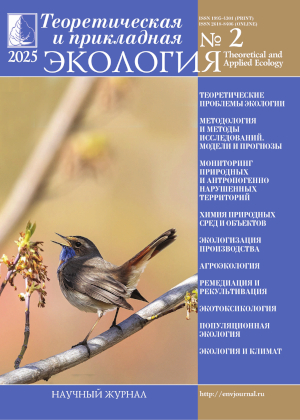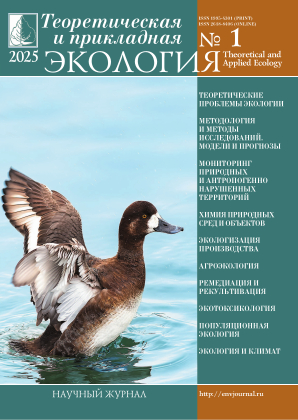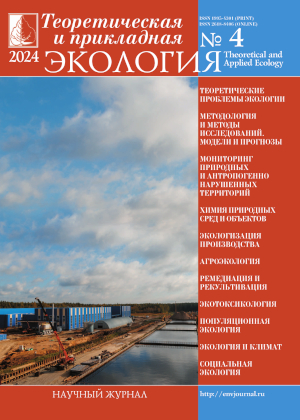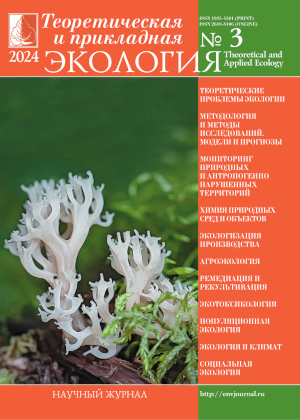 ISSN 1995-4301
ISSN 1995-4301(Print)
ISSN 2618-8406
(Online)
Online version of the journal
|
Degradation of poly(ε-caprolactone) under laboratory conditions during exposure to air and soil |
||||
| E.S. Shirokova, E.V. Tovstik, A.V. Sazanov | ||||
| Section: Remediation and rehabilitation |
||||
| Various aliphatic polyesters are used to provide biodegradable compostable packaging materials. They are a group of materials with a wide range of thermal, mechanical and biodegradability properties that can be easily adapted to a specific application. However, when using such materials for packaging solutions,their release into the environment after the end of the product’s service life is not excluded. In this regard, the assessment of changes occurring with polymeric material in soil and in air is of interest. The paper presents the results of assessing the degradation of films made from poly(ε-caprolactone) (PCL), one of the representatives of polyesters used for the production of flexible packaging, as well as high-density polyethylene (HDPE), which served as a reference sample. The experiment was carried out in laboratory conditions (natural light; temperature 20±2 оC) with exposure of the samples in the soil and in the air for 12 months. The changes in the polymer materials assessed by the appearance of the samples, the loss of their absolute mass, as well as IR spectroscopy and thermogravimetry data. The number of micromycetes in the soil in which the polymer samples were kept was indirectly judged to be biodegradable. The safety of degradation products was judged by the results of contact biotesting of soil us- ing radish (variety Zhara), carried out according to certified methods, taking into account international standards. The ability of polymeric materials to biodegrade under the action of micromycetes was confirmed in a fungus resistance test. A strain of mycelial fungus Fusarium proliferatum AC was a test culture. Degradation in the soil over the studied period was typical only for samples of PCL films. At the same time, the phytotoxic effect of PCL degradation products in the soil was not established. Signs of HDPE oxidation were indicated on the 3rd month of its air incubation. HDPE showed resistance to degradation in the soil. Based on the results of the work, a conclusion was made about the need to create special conditions for the disposal of PCL, despite its biodegradability proven in laboratory experiments. | ||||
| Keywords: poly(ε-caprolactone), polyethylene, soil, air, biodegradation, fungus resistance, Fusarium proliferatum АС |
||||
| Article published in number 2 for 2022 DOI: 10.25750/1995-4301-2022-2-165-172 |
||||
|
||||
Study of the effect of antibiotics on the urease activity of sod-podzolic and gray forest soils |
||||
| A.G. Kosmacheva, S.M. Chesnokova, T.A. Trifonova | ||||
| Section: Agroecology |
||||
| Environmental pollution with antibacterial drugs is associated with their massive use, and can affect the microbial communities of ecosystems and their functions, which determines the relevance of the study of such effects. Urease participates in the nitrogen cycle, promotes the breakdown of urea to ammonia. Ammonia, in turn, is a source of nitrogen nutrition for plants and microorganisms. The objects of research were sod-podzolic and gray forest agricultural soils. Antibiotics of various groups were used as pollutants, differing in the spectrum of action and physicochemical characteristics: tylosin, benzylpenicillin, oxytetracycline. The urease activity of the sod-podzolic soil without antibiotics was 0.951 g NH3 / 10 g soil * 24 hours, gray forest soil – 1.178 g NH3 / 10 g soil * 24 hours. The results of the study demonstrate the predominantly toxic effect of antibiotics on urease activity. The effect of drugs depends both on their concentrations and properties, and on the properties and type of soil. The urease activity of gray forest soil is higher than that of sod-podzolic soil, and is more resistant to the effects of antibacterial drugs. A triple mixture of antibiotics had the greatest toxic effect on the urease activity of the sod-podzolic soil. Tylosin had the greatest toxic effect on the urease activity of the gray forest soil. However, these effects were not dose-dependent (p>0.05). Significant negative correlation dependences were established of the urease activity of sod-podzolic soil on the concentration of oxytetracycline and its mixture with tylosin, and the urease activity of gray forest soil on the concentration of benzylpenicillin and a mixture of oxytetracycline with tylosin (p<0.05). | ||||
| Keywords: antibiotics, urease activity, sod-podzolic soil, gray forest soil |
||||
| Article published in number 2 for 2022 DOI: 10.25750/1995-4301-2022-2-183-190 |
||||
|
||||
Control of odor pollution of atmospheric air (review) |
||||
| N.V. Syrchina, L.V. Pilip, T.Ya. Ashikhmina | ||||
| Section: Theoretical problems of ecology |
||||
| Monitoring odor pollution (OP) of air is a complex analytical problem. Standard gas analysis equipment can be used to detect and measure the concentration of individual odor-forming substances (OFS) in the air. However, the presence or absence of odor on the basis of instrument readings is practically impossible to prove. The reasons are the subjective perception of odors, the complex multicomponent composition of the OP, the effects of synergism, masking, neutralization, which are manifested in the combined effect of various OFS on the human olfactory system. Today olfactometric method is used to measure the concentration of odors (group of experts are used as sensors). Measured by the olfactometric method the concentration of odor is expressed in odor of units per cubic meter (OU / m3). The most objective information about the OP can be obtained on the basis of a combined approach, including olfactometric and physicochemical research methods. The results of olfactometric research can be used to construct mathematical models of the dispersion of odors and to establish standards for OP. In addition to instrumental methods for monitoring the OP are used methods that do not require special equipment. There are methods of public opinion, analysis of complaints people about OP and method Citizen Science. Citizen Science is scientific work (collection of information, analysis of array of information, joint decision-making and so on). Citizen Science is carried out by citizens (volunteers) together with scientists or under the guidance of scientists. The experience of various countries shows that regulations aimed at control and minimization of OP can be established at the regional level. This approach will allow to maximally take into account the socio-economic characteristics of specific territories and optimize the costs of the budget and enterprises – sources of OFS for the implementation of measures to protect the environment and the people from OP. | ||||
| Keywords: odor pollution, atmospheric air, olfactometry, odor perception, odor analysis, odor control |
||||
| Article published in number 2 for 2022 DOI: 10.25750/1995-4301-2022-2-026-034 |
||||
|
||||
Tree diversity and carbon stock in North Poblacion and South Poblacion (Dipaculao, Aurora, Philippines) |
||||
| J.M. Bambalan, I.K.S. Palapal, R.V. Guleng, E.E. Coracero, R.B.J. Gallego, M.J.A. Suniega | ||||
| Section: Ecology and climate change |
||||
| Trees are very important components of an ecosystem which act as key elements of biodiversity which also provides countless benefits and protection from adverse events such as climate change. This study focused on the assessment of diversity and carbon storage potentials of tree species in Barangay North Poblacion and Barangay South Poblacion in Dipaculao, Auorora. The study covered a 100% inventory of the trees with diameter at breast height of at least 5 cm. The area was found to have a high overall diversity (H’ = 3.278; 1-D = 0.963) with 68 morpho-species of trees, 1290 individuals and 23 families. The most abundant species were Swietenia macrophylla King, Mangifera indica L., and Gmelina arborea Roxb. Ex Sm. collectively with 465 individuals. Ecological status assessment revealed 32 indigenous, four threatened (IUCN [18]), six threatened (DAO 2017-11 [19]), and three invasive species. Notable among the species were the three Philippine endemics – Artocarpus blancoi (Elmer) Merr., Ficus pseudopalma Blanco, and Drypetes falcata (Merr.) Pax & K. Hoffm. The overall tree biomass estimates were 2367.60 tons using Brown formula while 2328.90 tons using the equation of Chave. For carbon storage potential, the overall estimated values of two barangays were 1183.8 tons (16.28 t/ha) using Brown and 1164.45 tons (16.01 t/ha) using Chave. Samanea saman (Jacq.) Merr. had the highest carbon storage potential of 407.4 tons using Brown and 342.2 tons using Chave. The results of the study can serve as a guide to the local government in the planning the conservation and protection measures for the tree species in the area. | ||||
| Keywords: developed areas, Philippine trees, tree carbon stock, tree diversity, urban trees |
||||
| Article published in number 2 for 2022 DOI: 10.25750/1995-4301-2022-2-198-208 |
||||
|
||||
Microsatellite analysis of populations of the ussuri sika deer acclimatized in the European part of Russia |
||||
| A.P. Kaledin, S.V. Beketov, D.V. Zhukov, V.I. Fertikov, V.M. Makeeva, A.V. Smurov, A.M. Ostapchuk, E.А. Konorov, Yu.A. Stolpovsky | ||||
| Section: Population ecology |
||||
| In the Russian Federation, the indigenous population of sika deer (C. nippon hortulorum, Swinhoe, 1864) lives only in a small area of the Primorsky Kray. Since the beginning of the twentieth century, along with measures for the conservation of sika deer, they began to acclimatize it, with settling over a large territory and creating new habitats. Currently, up to 40% of the total population of sika deer in the Russian Federation is concentrated in the European part. Despite the long period of existence in the new ecological conditions, molecular genetic methods were not used in the study of sika deer. The presented work presents for the first time the results of microsatellite analysis of two populations of sika deer from Tver (Tver population) and Kaluga (Tarusa population) regions. F-statistics calculated for 12 STR-loci (BMS1788, Rt1, C143, OheQ, FCB193, C217, Rt24, C32, BMS745, NVHRT16, T40, C276) indicate a lack of heterozygous genotypes and indicate a weak divergence of populations. In the interpopulation comparison, the Tver population was distinguished by a greater allelic diversity and a significant number of private alleles. Genetic variability in observed and expected heterozygosity for the Тver population was HO 0,47 and HE 0,51 and for the Tarusa population – HO 0,52 and HE 0,49, respectively. At the same time, both studied populations of sika deer were characterized by a decrease in allelic diversity and heterozygosity relative to the “maternal” aboriginal Far Eastern population. Accordingly, at the present stage of hunting resource management, a reasonable artificial expansion of the range of rare and economically especially valuable animal species due to their dispersal and acclimatization is impossible without a genetic analysis of populations using highly polymorphic molecular markers and the use of standard estimated indicators of dynamic processes in populations. According to the results of the study, it can be concluded that the genetic diversity of the studied acclimatized populations of sika deer in the Tver and Kaluga regions does not differ significantly, and the observed difference in private alleles suggests an independent development of the gene pools of the populations under consideration. | ||||
| Keywords: sika deer, populations, introduction, microsatellites, allelic variability, genetic divergence. |
||||
| Link | ||||
| Article published in number 2 for 2022 DOI: 10.25750/1995-4301-2022-2-130-137 |
||||
|
||||
Utilization of wastewaters as a nutrient medium for the accumulation of microalgal biomass |
||||
| A.V. Gogonin, T.N. Shchemelinina, E.M. Anchugova | ||||
| Section: Population ecology |
||||
| Cultivating microalgae using wastewater nutrients is a potential approach to realize resource recovery that can contribute to circular economy. However, wastewaters discharged from pulp and paper mills contain high concentrations of recalcitrant compounds such as metal ions, phenols, nitrogen compounds, sulfur, phosphorus, that exceed quality standard values, that is why microalgae-based approaches are a solution to cope with wastewater treatment and simultaneous biomass accumulation. To address those problems, we investigated microalgal cultivation fed with nutrients from wastewaters, synthetic, and semi-synthetic media. This study employed the species of Chlorella genus adapted for technologies of algal ponds and stepwise bioprocessing approaches. Biotechnological properties of Chlorella vulgaris f. globosa strain were evaluated in a series of laboratory experiments testing a range of regimes and conditions. Results showed that C. vulgaris f. globosa grew well on both semi-synthetic Liuk’s medium and synthetic conventional media because of its similar nutrient profile to a common algal growth medium, but wastewaters were found to be the most appropriate for scaling up of beneficial acclimatized biomass production. Microalgae inoculation affects the content of major pollutants while treating real wastewater of Mondi Syktyvkar JSC. Nutrients, metal ions, and other recalcitrant pollutants were effectively removed by this strain with removal efficiencies of 74–79% NH4+-N, 42–44% NO3--N, 25–50% total phosphorus, 6.4% total sulfur, and 62–70% of phenols, respectively. After microalgal cells having been deposited and harvested, chemical parameters of the wastewater processed were in compliance with quality standards for fishery waterbodies. It might be useful, in a framework of further studies, to assess toxicity of the biomass harvested and its applicability for agriculture. | ||||
| Keywords: wastewater, pollutants, microalgae, wastewater treatment, nutrient medium. |
||||
| Article published in number 2 for 2022 DOI: 10.25750/1995-4301-2022-2-109-115 |
||||
|
||||
To the question of methodological support for determination of rare earth elements for industrial inspection |
||||
| T.S. Ulanova, M.V. Volkova, G.A. Veikhman, A.V. Nedoshitova | ||||
| Section: Ecologization of industry |
||||
| The purpose of the study is the development of methodological support for the determination of rare earth elements (REE) in workplace air and biological media (blood) of workers. New methodical guidelines for the determination of REE in the workplace air and whole blood in a wide range of concentrations by the method of inductively coupled plasma mass spectrometry are presented. It is proposed to use these methods for production control at the enterprises of mining and metallurgical industries. Also it is recommended to use the test for the determination of REE in biological media (blood) of workers to assess the sufficiency of measures for organizing safety and reducing harmful production factors, along with monitoring the air quality of the working area. The methods are included in the Federal Register of Measurements: FR.1.31.2018.31642 for the cerium group; FR.1.31.2018.31641 for the yttrium group in the air of the working area, patent No. 2697479; FR.1.31.2019.32618 for the determination of REE in blood, patent No. 2696011. The developed methods meet the modern requirements of standardization and metrological certification, they have high sensitivity and selectivity. The methods have been successfully approbate at a metallurgical enterprise for determining the concentrations of REE in the blood of workers and in the workplace air. | ||||
| Keywords: rare earth elements, toxicity, workplace air, blood, mass spectrometry with inductively coupled plasma |
||||
| Article published in number 2 for 2022 DOI: 10.25750/1995-4301-2022-2-101-108 |
||||
|
||||
The effect of dried blueberries and food products enriched with them on metabolic parameters of carbon tetrachloride intoxication |
||||
| A.V. Elikov, P.I. Tsapok, E.M. Karpova, D.B. Loktev, V.A. Kozvonin, L.N. Shmakova | ||||
| Section: Ecotoxicology |
||||
| The aim of our study is to estimate the efficiency of using functional food supplements enriched with blueberry (Vaccinium uliginosum L.) powder to reduce carbon tetrachloride intoxication manifestations. The influence of the inclusion of dried blueberries on the indicators of protein metabolism, as well as food products based on bread and cottage cheese with the dried blueberries in their recipe, was investigated. Those parameters were evaluated by the content of total protein, medium molecular peptides, De Rittis coefficient and oxidative balance (assessed by the content of TBA-active products, ascorbic acid and total antioxidant activity index) in the blood plasma in rats intoxicated with carbon tetrachloride. The biological effect of including blueberry powder was achieved by replacing an equivalent part of the standard vivarium diet with dried blueberries, white bread and cottage cheese enriched with blueberry powder for 14 days. All animals were divided into twelve groups, six of which remained intact and six were simulated total body intoxication by subcutaneous injection of 66% tetrachloromethane solution. The control group consisted of animals kept on a standard vivarium diet. It has been established that the addition of blueberries to the diet both in a free form and as a part of the functional foods has a significant positive effect on the metabolism. It is confirmed by studying the protein exchange state (increasing values of total protein and decreasing of average molecular peptides) and the oxidant balance (decreasing the concentration of TBA-active products, increasing of ascorbic acid and total antioxidant activity). Inclusion of blueberries in the diet during the introduction of carbon tetrachloride significantly reduces the severity of intoxication, which was expressed in higher values of De Rittis coefficient and lower concentration of medium molecular peptides and TBA-active products. Using enriched cottage cheese is the most effective way to reduce the manifestations of intoxication. It is confirmed by changes of indicators’ level in comparison with the vivarium ration group: the De Rittis coefficient is increased by 39.6% (p < 0.001), total protein – by 39.8% (p < 0.001), ascorbic acid – by 3.12 times, total antioxidant activity – by 29.6% (p < 0.001). The indicators of average molecular peptides are decreased by 19.1% (p < 0.001), TBA-active products – by 35.2% (p < 0.001). | ||||
| Keywords: nutrition, food supplements, metabolism, antioxidants, carbon tetrachloride, general intoxication, free-radical oxidation |
||||
   |
||||
| Article published in number 2 for 2022 DOI: 10.25750/1995-4301-2022-2-070-076 |
||||
|
||||
Distribution features of Xanthogaleruca luteola (Coleoptera: Chrysomelidae) in the protective plantings of the Lower Volga |
||||
| O.S. Filimonova, M.N. Belitskaya, I.R. Gribust | ||||
| Section: Population ecology |
||||
| Presented data on the features of ecology of economically dangerous pest - Xantogaleruca luteola (Coleoptera: Chrysomelidae). The development of leaf beetle occurs exclusively on woody plants of the Ulmus L. ancestral complex, which account for about 80% of the total composition of dendroflora in the Lower Volga. In the conditions of the study region, phyllophage is recorded on U. glabra, U. pumila, U. laevis. The greatest degree of foliage damage is noted for hornbeam elm, in the crown of which the defoliation level reaches 93%. This species prefers to populate the lower tier of the crown of trees, where when illumination is no more than 1500 lux, the maximum density of leaf food is recorded (more than 40 individuals per 100 leaves). The quantitative abundance of the pest is subject to significant fluctuations under the influence of weather conditions. During the drought period, there is a sharp hanging of the population density due to the weakening of trees. The regulatory factor limiting the growth of leaf beetle is the aggravation of intraspecific relations with an increase in population density, which entails a decrease in the potential for reproduction. So, the number of eggs in the clutches of females after leaving the diapause fluctuates at the level of 21-23 pcs/100 leaves. When the pest is restored, the number of eggs in the clutches of the II generation decreases by 22.1%. It was revealed that the number of clutches and eggs in the clutch varies significantly from a species of woody plant. The Imago mainly lays eggs in the crown of U. glabra, while the number of eggs in the clutch is minimal. The established differences are obviously related to the preference of hornbeam elm as a fodder plant, which entails an increase in population density and the number of masonry on the leaves in the crown of this type of elm. The decrease in the number of eggs in the clutch is due to the development of stress in females with a high frequency of contacts between individuals. Thus, the presence of mechanisms for regulating the abundance of ilm leaf beetle indicates the successful adaptation of the pest to the conditions of the Lower Volga. | ||||
| Keywords: phyllophages, Xanthogaleruca luteola, Ulmus, Lower Volga |
||||
  |
||||
| Article published in number 2 for 2022 DOI: 10.25750/1995-4301-2022-2-124-129 |
||||
|
||||
Maximum entropy modelling for predicting the potential distribution of methanogens in Sundarban mangrove ecosystem, India |
||||
| N. Das, A. Mondal, S. Mandal | ||||
| Section: Methodology and research methods. Models and forecasts |
||||
| The production of methane (CH 4 ) by methanogens (Mgen) in mangrove sediments is known to contribute significantly to global warming. In such an estuarine environment, the abundance and population assemblage of Mgen are not well understood. Recently, there has been an increase of interest to understand about the properties of habitat distribution and the main environmental factors that influence mangrove suitability. Here, we used a maximum entropy (Maxent) species distribution model and a geographic information system (GIS) to determine the current habitat suitability distribution of Mgen in the Sundarban mangrove ecosystem in India. The Worldclim elevation (elev), precipitation (precp), solar radiation (srad), average temperature (tavg), maximum temperature (tmax), minimum temperature (tmin), water vapor pressure (vap) and the wind speed (wind) data and 36 spatially well-dispersed species occurrence points were used to predict the potential distribution of Mgen in the 14,317 km2 study area. The results indicated that Mgen has a high potential distribution at the deforested areas adjacent to the riverine system in the Indian Sundarban mangrove ecosystem. Jackknife test was used to evaluate the importance of the environmental variables for predictive modeling. The prcp is the most important environmental variable which influences the distribution of Mgen in mangrove sediments. With an AUC (area under curve “Sensitivity vs. Specificity”) of 0.826, the Maxent model was extremely accurate. The study shows that Maxent could be a useful tool for species rehabilitation and biodiversity conservation planning in the face of climate change. | ||||
| Keywords: methane, entropy, maxent model, ecological niche |
||||
| Article published in number 2 for 2022 DOI: 10.25750/1995-4301-2022-2-042-047 |
||||
|
Pages: previous 1 2 3 4 5 6 7 8 9 10 11 12 13 14 15 16 17 18 19 20 21 22 23 24 25
|
36, Moskovskya street, Kirov, 610000, Editorial Board "Theoretical and Applied Ecology." Phone/fax: (8332) 37-02-77 e-mail: envjournal@vyatsu.ru The journal was founded in 2007 |
||||||




 Select viewing options
Select viewing options